This is an Ebner 4.5×6 folding camera produced by Albert Ebner & Co. in Stuttgart, Germany between the years 1933 and 1935. There were two Ebner cameras made, this one and a 6×9 version, neither of which were identified by any name other than the size of the images they made. Strangely, only the 4.5×6 model uses Kodak’s 620 format roll film, making sixteen images per roll. The Ebner’s body is made entirely of a marbled brown Bakelite material and uses a Compur leaf shutter that came with a variety of lenses. Ebner cameras were produced for a very short period of time as the Albert Ebner & Co. would go out of business in 1935.
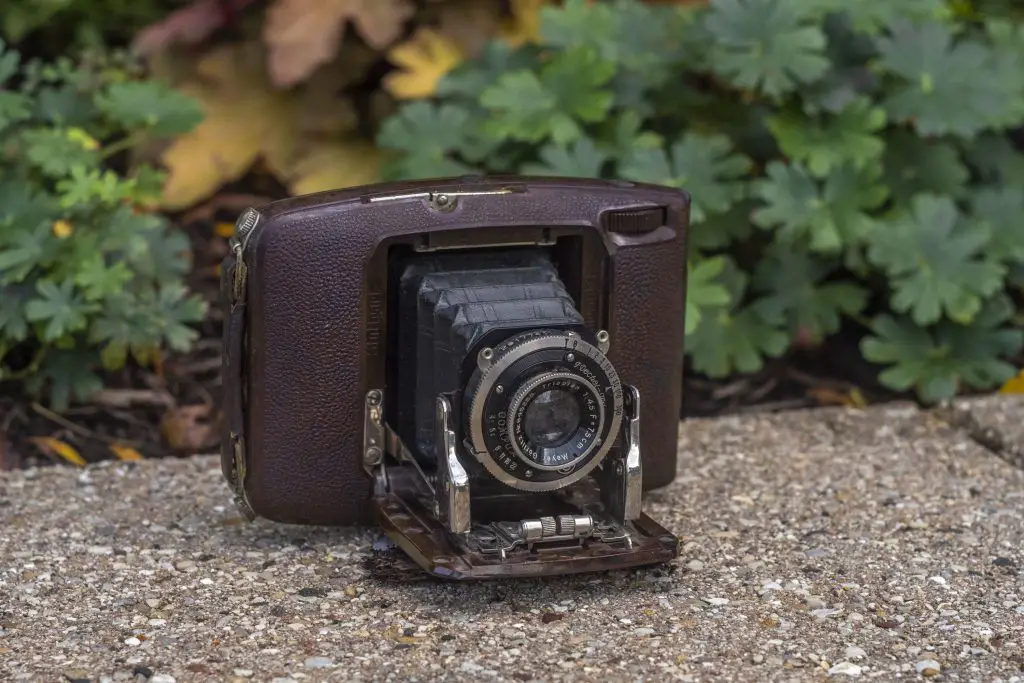 Film Type: 620 Roll Film (sixteen 4,5cm x 6cm exposures per roll)
Film Type: 620 Roll Film (sixteen 4,5cm x 6cm exposures per roll)
Lens: 7.5cm f/4.5 Meyer Gorlitz Trioplan uncoated 3-elements
Focus: Variable if SLR, 2.6 feet to Infinity with Click Stops for Portrait, Group, and Scenery
Viewfinder: Folding Scale Focus Wire Frame
Shutter: Compur Leaf
Speeds: T, B, 1 – 1/300 seconds
Exposure Meter: None
Battery: None
Flash Mount: None
Weight: 479 grams
Manual: None
How these ratings work |
The Ebner 4.5×6 is a little known camera by an even littler known company. Sporting an attractive marbled brown Bakelite body with soft curves making it very portable, the camera is really just another folding German roll film camera. This example has a nice Trioplan triplet lens set in a Compur shutter that should make it capable of decent shots, but in Ebner’s desire to make the camera as portable as possible, they included a very poor viewfinder design which I found frustrating to use. If all you’re looking for is a cool looking camera for display, or if you just really like pre-war German folding cameras, this is definitely for you, but if you want to use it, there are far better options in this genre. | ||||||
| Images | Handling | Features | Viewfinder | Feel & Beauty | History | Age | |
| 1 | 2 | 1 | 0 | 2 | 0 | 20% | |
| Bonus | none | ||||||
| Final Score | 7.2 | ||||||
History
In the years prior to World War II, there were a great deal of companies producing cameras in Germany. Names like Zeiss, Leitz, and Voigtländer were three of the most championed marques in the country’s history and there is no shortage of historical information about each of the products produced by these companies.
But for every Balda or Welta that was churning out cameras in the 1930s, there were companies like Albert Ebner & Company who barely made a dent, producing only one or two models for a very short time.

Born in 1891 in Bad Cannstatt, not much is known about Albert Ebner other than in 1919 he formed his first company which produced a variety of electrical components, but primarily turntable motors for gramophones. From what limited information I could find in German language websites and then translated via Google, Ebner’s first company would fail and either be acquired or merged with another company called Elektromophon AG Stuttgart whom he previously provided parts for.
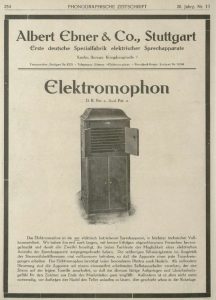
The ad to the left is from January 1920 and shows one such gramophone with the names Elektromophon and Albert Ebner & Company, Stuttgart which suggests these gramophones were sold under his name. I am unsure of exactly what the relationship was between Ebner’s company and Elektomophon but I guess that’s not really important.
In the 1920s, Albert Ebner continued to refine his hybrid electronic and spring wound turntable drive, integrating them with the company’s lineup of floor standing and table top gramophones. As best as I can tell, Ebner’s gramophones were elegantly crafted and carried a premium price tag compared to competing models. The few examples of these gramophones I was able to find on Google are all very ornate, suggesting they were a luxury item.
By the late 1920s, after years of economic turmoil, Ebner’s company would enter into bankruptcy and it’s last products discontinued in 1930. Undeterred, Ebner would leave Stuttgart and return home, back to Bad Cannstatt and form yet another Albert Ebner & Company (often abbreviated AECO) who would continue producing turntable parts, but also expanding to include other products such as vacuum cleaners, electrical pneumatic pumps, fans, and eventually cameras.
Ebner would not be the first audio related company to try their hand at producing cameras as both International Radio Corporation (Argus) and Detrola made the same jump using their expertise with Bakelite to create an inexpensive, but durable camera. Like those companies, Ebner used what they knew and created an attractive and elegantly designed shell around a relatively simple and straightforward folding bellows design.
Only two Ebner cameras were produced, one that shot 6×9 images on 120 roll film and another that shot 6×4.5 images, strangely on Kodak’s 620 format of roll film. This was unusual as very few German companies outside of Kodak AG supported Kodak’s new 620 format, but even stranger is that the larger 6×9 camera used regular 120 film.
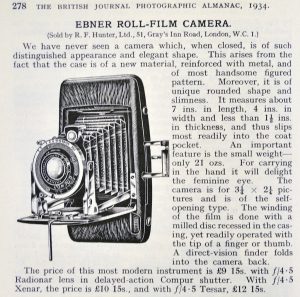
Most Ebner cameras come in a marbled brown Bakelite body that may or may not have been designed to appeal to women. In the only ad I could find for either Ebner camera to the right, the 1934 British Journal of Photography says that the camera’s distinguished and elegant shape will delight the “feminine eye”. Whether or not this suggests this camera was specifically marketed to women is unclear, but even if it was, it wouldn’t be the first or even last as companies like Certo, Argus, and Nikon have all done it at various parts during the 20th century.
Both the 6×9 and 6×4.5 models came with a variety of shutter and lens combinations, but most were found with simple triplets and Compur shutters. A very small number of 6×4.5 models came in an all black body. The 6×9 model may have too, but I’ve never seen one.
With the only ad showing the 6×9 model in British pounds, I cannot even guess at what this camera might have sold for in the US. A short blurb in the October 1982 issue of Popular Photography suggests the camera was imported in 1935 by Willoughby’s of New York, but no price is listed. If anyone reading this has access to the 1935 Willoughby’s catalog and can look for me, please let me know.
Interestingly, a couple years after Ebner stopped making cameras, the French camera maker Gallus would produce a camera that looked the same as the Ebner 6×9 called the Gallus Bakélite. Featuring the same marbled brown Bakelite body, and a nearly identical setup of viewfinder, shutter, lens, and folding mechanism, it is very possible that Gallus purchased the tooling and rights to the Ebner camera and sold it under it’s own name. Also around the same time, a variant of the Gallus Bakélite called the Pontiac Bakélite which was identical, save for the name printed on the shutter ring.
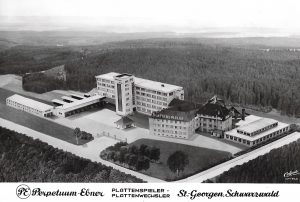
Both Ebner cameras were produced for a short time, with most sources agreeing that by 1935 were no longer in production. It would seem that yet another of Albert Ebner’s companies was on the verge of failure when in 1936 he married a woman named Hermine Steidinger who was co-owner of an audio company called Perpetuum, Steidinger and Company and shortly thereafter, the assets of Albert Ebner and Company would be merged with his wife’s company to form Perpetuum Ebner, Factory for Precision Mechanics and Electrical Engineering.
The new company would continue to manufacture audio equipment and at one time even had it’s own record label. Albert Ebner would remain part owner of Perpetuum Ebner until his death in 1956. The company would continue on until 1973 at which time it would be shut down, only to be revived again in 2015 by Wolfgang Epting under the name WE Audio Systems.

The current day Perpetuum Ebner website lists a variety of very elegant, but insanely expensive turntables with the top of the line model being the PE 4040 Mk II with a retail price of $8570. If that’s not enough of a sticker shock for you, PE’s parent company has another line of even more expensive turntables with the top model being the Döhmann Helix One MkII with Titanium finish for the low-low price of $79,400.
Today, there aren’t many people who have ever heard of the name Ebner, and for those that have, they usually know them from their audio business, rather than the 2 years that they made cameras in the 1930s.
Still, there is likely a market for these cameras, as pre-war German folding cameras are always sought after, and with the marbled brown Bakelite bodies, there weren’t many other cameras that look like an Ebner. They will likely be very hard to come by, but their obscurity might help you get a rock bottom price (it did for me), so it might be worth adding to your eBay watch list!
My Thoughts
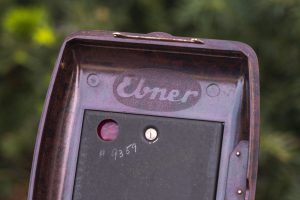
They say that “beauty is in the eye of the beholder” and as someone who beholds the Ebner 4.5×6, I can definitely say this is a very attractive camera. I am not ashamed to admit that as soon as I saw this one in a lot of others, that I bought the whole lot just for this one camera.
Ebner cameras were produced for a very short time, but the ones that were produced usually came in a marbled brown Bakelite body like this one. I must confess that while shooting pictures of this camera, it was very difficult to accurately capture the exact color of the body. Looking at these images on my computer monitor does not do the camera justice as it looks much nicer in person.
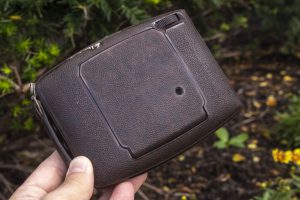
The entire body of the camera is not only pretty to look at, it is nicely contoured so that when it is folded shut, it easily slips in and out of most medium sized pockets or a purse. I theorized above that this camera may have been marketed towards women as it sort of resembles a larger version of those clam shell makeup cases that ladies use for their faces (I have no idea what they’re called).
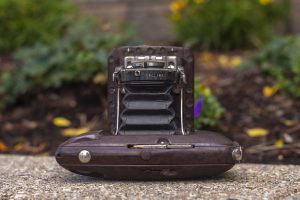
Opening the camera simply requires pressing a button that is smoothly contoured into the center of the top plate. The camera is self erecting and will pop open with a decent amount of force, although this example needed a little bit of help to fully open, which can just be a result of age.
With the camera open and looking down at it from waist level you see a standard Compur shutter. The shutter is mounted sideways on the Ebner which places the shutter release near the 10 o’clock position and the cocking lever near the 2 o’clock position which is conveniently located in easy reach of your left and right index fingers. I quite like this orientation compared to some other folding leaf shutter cameras where the shutter release is near the bottom edge of the door and hard to reach. Shutter speeds are changed via a ring around the shutter and apertures with a small lever near the edge. After writing this, it thought that perhaps it’s possible the shutter on this one was rotated like this by some previous owner but a Google and Flickr search returned others like mine, so this is likely normal.
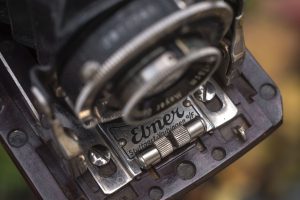
When it is time to close the camera, you must press two cylindrical metal posts at the base of the shutter inward, while simultaneously lifting the door to close it shut. Behind the metal posts is a nice Ebner Stuttgart-Vaihingen logo.

The viewfinder is a very rudimentary metal frame that collapses to the side. There is no glass element in the window as it would be impossible for it to fold this way, but that has the negative side effect of being difficult to use.
On the top of the back of the camera there is what appears to be a second part to the viewfinder which on mine is broken. A post likely would have swung up as a locating point for your eye to correctly frame the image in the camera. Even though the post was broken on mine, I have seen this style of viewfinder on other folding cameras with wire frame finders, and I find them to be very difficult to use as they really only give an estimation of the frame.

Opening the film compartment in the Ebner requires sliding a door lock that is hidden beneath the leather strap on the camera’s right side. The first time I handled this camera, it actually took me a bit to find the lock as the strap was stiff and tight to the body. The stiffness of the strap suggests it hasn’t seen much use in it’s life.
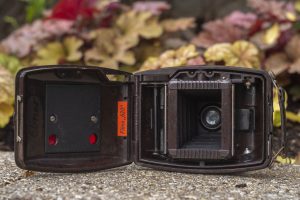
The left hinged film compartment reveals a pretty ordinary roll film compartment. The Ebner 4.5×6 is designed to use Kodak’s 620 style of film, but I found that each of the two film compartments are large enough that normal 120 spools fit fine on both sides.
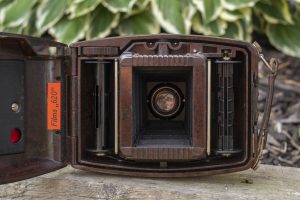
Although the spools fit fine, it wasn’t until I tried loading in some 120 film into the camera when I saw problems. The issue is that the “key” for 120 spools is larger than for 620, and when putting in a 120 spool into the camera and trying to roll film onto or off a spool, the 120 spool becomes dislodged and won’t spin correctly. You can spin it with your fingers with no film on it, but transporting film from spool to spool wouldn’t work, so you can’t simply use 120 film in this camera without somehow modifying the spools or the key.

Advancing the film, both with the door open and closed is extremely easy as there is a wheel above the take up spool that can be rotated both from the back and front of the camera. This is a nice touch that allowed for a normal wheel to be used while maintaining the smooth contours of the body.
The back of the camera has two red windows which both need to be used for counting exposures. The Ebner 4.5×6 shoots images that are half that of a 6×9 camera and in the early days of 120 and 620 roll film cameras, the backing paper didn’t consistently have exposure numbers 1 through 16 for a 4.5×6 exposure size.
So in order to count your exposures, you use the numbers for 6×9 images twice. The first exposure is made when the number 1 is in the right window. For the next image, advance the film until the number 1 is in the left window. For the third, advance until the number 2 is in the right window, and keep doing that until the 16th exposure is made with the number 8 in the left window. This is exactly the same kind of system that cameras like the Foth Derby using 127 film worked that shot “half” 3×4 images.
And that’s pretty much it. Other than a tripod socket on the front edge of the folding door, there’s not much else to say about the camera. When it comes down to it, the Ebner is just another folding medium format camera. Other than the viewfinder, it’s operation is no different from many other cameras of the same era. The camera excels in beauty and compactness and for that, it could be the perfect compact medium format camera. Or is it?
My Results
The Ebner uses Kodak 620 roll film which isn’t made any longer, but is really just regular 120 on a smaller spool, so for my first roll through the camera, I took a lightly expired roll of Kodak Portra 160NC and rolled it onto one of many 620 spools I have and loaded it into the camera.
There are those cameras in which the shooting experience is transcendent and natural. You reach the end of roll of film quicker than you thought you would and can’t wait to load in your next roll, and the one after that.
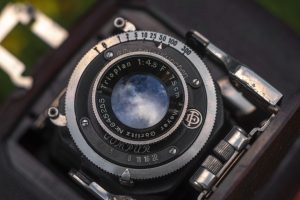
This is not one of those cameras. To be fair, the Ebner 4.5×6 accomplishes it’s intended task as good as any 1930s folding roll film camera should. I did like the sideways orientation of the Compur shutter putting both the cocking and shutter release levers at the top of the camera instead of down by the hinge like on some other cameras, and it certainly is pretty, but I really hated that viewfinder.
The Ebner’s viewfinder is a glass-less metal frame with a secondary framing post on the back of the camera. On my example, the post was broken off, but even had it been there, framing your image would still be incredibly difficult. Thinking about cameras like the Kodak Duo Six 20, which was another 1930s folding 6×6 German camera that uses 620 film, that camera has a flip up glass viewfinder that is very easy to use. The one on the Ebner isn’t. I found it especially difficult to know exactly what would be in my frame as it would change depending on how far away your eye is from the frame. Looking at the gallery above, images of the playground, the street, and a couple of the cars are off. I tended to aim high with the camera as I was unable to properly frame my images.
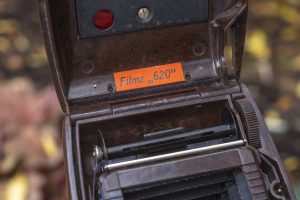
The Trioplan lens did a decent job, as good as any triplet would do on a medium format camera. Center sharpness is good with just enough softness and vignetting near the corners to give a vintage look for people who like that sort of thing. It turns out the Portra was more expired than I thought it was as the colors came out very strange on some but I can’t blame the camera for that.
I definitely appreciated the compactness and portability of the Ebner. While cameras like the Kodak Retina were very compact too, they shot smaller negatives. There weren’t as many medium format folding cameras of this era that took portability into account, so for that, the Ebner was a success.
It’s clear to me how much I value a good viewfinder however, and with the one on this camera, it pretty much negated my desire to ever shoot it again. The rest of the camera worked fine, and it has an attractive and compact appearance which means this will make for a pretty shelf queen.
External Links
http://camera-wiki.org/wiki/Ebner
https://sites.google.com/site/harrissonphotographica/home/ebner
http://web.archive.org/web/20191023113901/http://www.ukcamera.com/classic_cameras/ebner1.html
http://www.marriottworld.com/stock_pics/rollpics/ebner.htm
https://grammophon-platten.de/e107_plugins/forum/forum_viewtopic.php?29138

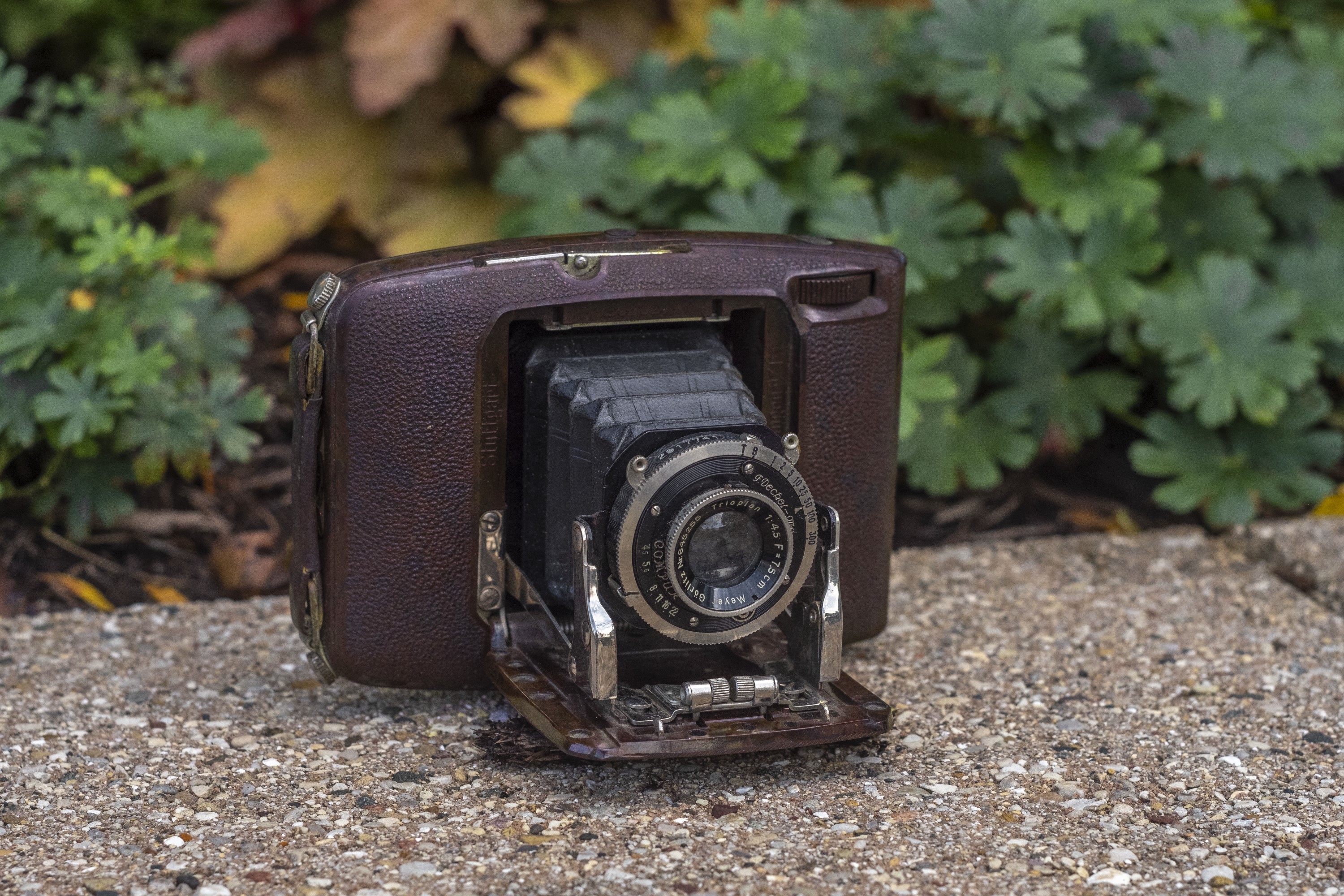
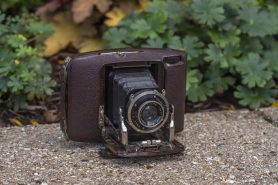












Once again-great review. Like the Kodak Regent, the Ebner is great to look at, not so nice to use. I am lucky to have both, and other folding cameras that are more functional, if less lovely
It’s funny you mention the Kodak Regent as I have one of those too, and you’re right, it wasn’t the best to use. I applaud the inclusion of a coincident image rangefinder on it, but it’s so difficult to use. I ended up just guess focusing it and got a roll of 8 out of focus shots, so that cameras sits on the shelf of cameras that I need to come back to at some point in the future!
Mike, as you say, an attractive camera, and I certainly agree with you on this. But for me, I would have expected better performance, even in a triplet design, and I find things decidedly odd in some of the images you’ve posted. Nothing appears remotely sharp and focus appears all over the place from frame to frame. I’ve seen Box Tengors with their doublet Frontars producing better results. So what’s going on?
At first I did wonder if the camera focused in similar vein to some of my very early roll film cameras from Contessa-Nettel and Kodak, Model 3A Special, and which focus using a linear scale on a plate attached to the baseboard. But then I noticed from one of the images that the Ebner is a front cell focusing unit. The problem with front cell focusing, as I’m sure you will have come across, is that people mess with them and then don’t have the means to accurately adjust focus when screwing the element back in.
The issue with this Ebner is that focus isn’t consistent from shot to shot, and this is very noticeable when comparing the images of American cars of the past. However, the weirdest image showing that something isn’t right with the Ebner’s set-up is the last image of the cars you post. If you look at this and especially the red brick building at the left of the frame you will see that the frontage appears distinctly bowed outwards. Now compare this with the similar shot with the light blue Chevrolet and the building appears normal.
So now my thoughts are on the film and perhaps this is not being held flat at the film plane, or in the correct positon relative to it. Certainly, to me, the bowed building indicates some buckling of the film. Any thoughts?
Very observant Terry! Truth be told, this was a camera I wasn’t that enamored with. I didn’t enjoy shooting it and after seeing the images it made, this review languished for quite some time before I just decided to rush through and finish it. The pressure plate on this camera is screwed into the inside of the door and has no movement like most cameras. I’ve seen other cameras where the film door acts as the pressure plate and that often causes film flatness issues like the ones here. To be honest, I missed that in my analysis, but I bet that’s what caused the inconsistencies within the same frame.
Regarding overall missed focus, another truth I left out of the review is that when this camera came to me, the shutter was stuck. I had to take it apart and clean it and while putting it back together, I struggled to collimate it. Again, being a camera I wasn’t that thrilled with, I didn’t take any pictures of the repair and failed to mention it in the review. So the person you speak of that likely messed with the front cell focus is me (and possibly other previous owners) 🙂
Thanks for the in depth analysis, you might have spent more time looking at the images than I did! By any chance, are you interested in helping me write future reviews! 🙂
Mike, I’ll get in touch.